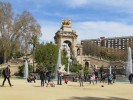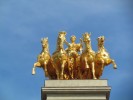- #ES06
- Passeig de Picasso, 21, 08003 Barcelona, Spain
- 41.3881480, 2.1862120 Copy to clipboard Copy
-
#Parks
On the grounds of the Parc de la Ciutadella, there are several attractions: the zoo, the Catalan Parliament. The Museu d'Art Modern is situated in the building of the parliament. The Zoological Museum and the Museu de Geologia are placed in the area of the park.
In 1714, after the successful war at the time of Felip V., a citadel was placed on this ground. To build this fortress, Felip V. pulled away a considerable part of the quarter Ribera.
Therewith, the Bourbon king wanted to put the people under his control. La Ciutadella represented everything that the Catalans hated: the Bourbons and the central government in Madrid. Later, the Citadel was converted into a prison - mostly for political prisoners.
At the north-western entrance of the Parc de la Cuitadella, at the Passeig de Pujades, one will find a equestrian statue of General Prim, who gave the order for sanding the citadel in 1869.
The 1869 warrant for the grinding of Zidadelle existed. In 1998, the World Exhibition was placed here.
The park was designed under the command of Josep Fontsère, the young and then unknown architect Antoni Gaudí supported him with the design of the waterfall "Cascada. Gaudí immortalised himself on the fountain, which stands by the lake. The water basin in front of fountain is guarded by winged dragons, a figure quite commonly found in his work.
The Parlament de Catalunya can be vistited on the first Friday of the month with a guided tour (in Catalan). Similarly, the building is open to visitors on 11th September (the Catalan national holiday) and 12 th September. In the parliament building, the Museu d'Art Modern has got its place.
The buildings on the west side of the park
Many of the Modernism buildings are still preserved, but a little more attention to them and care would do well. Four very remarkable buildings are located on the side of Passeig de Picasso, the southwestern side of the Parc de la Ciutadella.
Castell dels Tres Dragons (Castle of the three Dragon)
The northernmost of the buildings, the Castell dels Tres Dragons (Castle of the three dragons), houses the Zoological Museum. The brick house is an example of early Modernism. The building was built in 1887 by architect Lluis Domènech i Montaner, one of the leading representatives of the Catalan Art Nouveau. Since 1920 it houses the Zoological Museum. The Castell dels Tres Dragon is a good example that the performance of Modernism in particular consisted of to combine different styles and techniques. The construction with bricks and bearing steal elements was inspired by the then very famous Amsterdam Stock Exchange. The towers and battlements are reminiscent of the Moorish style. The art to decorate building facades with ceramics, was revived and became an important technique of Modernism.
Hivernacle
Right next to the Castell dels Tres Dragons the winter garden "L'Hivernacle" is located. The winter garden is a pavilion made of cast iron and glass. The architect was Josep Amargós. In the summer is a particularly nice café. There are also several jazz concerts. The plan had the building Amargós in 1884, at a time when the architecture had the steel and glass constructions by Eiffel as a model. The Hivernacle is still attributed to the Modernisme. The building was inaugurated in 1888 to the World Exposition.
Geological Museum
The Hivernacle located next to the building of the Geological Museum, built in 1882 by Antoni Rovira i Trias in neo-classical style. The construction of the museum was made possible by a donation from Francesc Martorell Peña. It was the first museum in Barcelona and it has today a large collection of minerals.
Umbracle - Tropical greenhouse for shade-loving plants
The Umbracle is a wood-brick construction. In it grow large tropical plants, which prefer the shadow of the great virgin forests. Although this building needs an urgent rehabilitation, but it offers a very impressive atmosphere in the interior. The architect was also Amargós, finished to the World Exposition in 1888.


